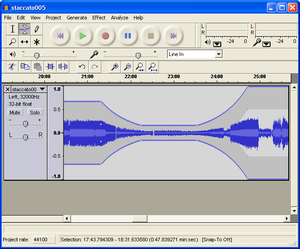 I must admit I’m not very fond of audio editing tools. Mixing music has never been my cup of tea, so when it comes to testing an audio editor, chances are I end up more confused than satisfied. However, this isn’t the case with Audacity. To begin with, this editor is free source and supports MP3, two features which usually don’t meet in this kind of application. Secondly, it’s easy to master, even for newcomers. And finally, there’s a wide range of filters and special effects you can apply to your music so that you easily achieve the desired effect.
I must admit I’m not very fond of audio editing tools. Mixing music has never been my cup of tea, so when it comes to testing an audio editor, chances are I end up more confused than satisfied. However, this isn’t the case with Audacity. To begin with, this editor is free source and supports MP3, two features which usually don’t meet in this kind of application. Secondly, it’s easy to master, even for newcomers. And finally, there’s a wide range of filters and special effects you can apply to your music so that you easily achieve the desired effect.
Audacity doesn’t stand out for its interface. At first sight one wonders if this program is really going to be that easy to use. In fact, the interface sometimes makes it really hard to work with your tracks, especially when you zoom in on them for a more comfortable editing session. Besides this, I found myself constantly right-clicking on the working area and the tracks too, waiting for some handy context menu to appear but nothing came out.
After these few first minutes struggling with the interface, it’s time to begin having fun. You can open as many tracks as you want by just dragging and dropping audio files onto the program’s interface. Use your mouse to select the fragment you’re interested in and begin working with it. You can perform the basic editing actions (cut, copy, paste) or apply effects to it. The zoom tool helps a lot when selecting small areas, as well as the chronometers found at the bottom of the program’s window. Obviously, you can use the integrated player to check how your work sounds before saving the project.
 Audacity features quite a large selection of filters and effects. Each one has its own setting options to adjust it to your liking. But what I loved is the possibility to preview how the filter will look on the audio track. This preview function allows novice users to test each filter before actually using it and also configure it with great accuracy.
Audacity features quite a large selection of filters and effects. Each one has its own setting options to adjust it to your liking. But what I loved is the possibility to preview how the filter will look on the audio track. This preview function allows novice users to test each filter before actually using it and also configure it with great accuracy.
On the downside, Audacity doesn’t have much more to offer. After a few days playing with the program, you soon grow tired of selecting audio fragments and adding effects, and you feel like you need something else. In other words, the simplicity of the program makes it easy to learn, but at the same it makes it too basic and requires a lot of creativity on the user’s side to obtain ear-catching results. Anyhow, Audacity is still a perfect choice to take your first steps in the music mixing world and then perhaps move on to another more professional tool.

